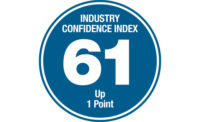1Q 2025 Cost Report: Construction Execs Optimistic for the Year Ahead

ENR’s Construction Industry Confidence Index rose six points between Q4 2024 and Q1 2025 to a rating of 61. That is the index’s highest rating since Q1 2022. However, it is down three points in comparison with last quarter’s post-election confidence rating.
The confidence index measures executive sentiment about where the current market will be in the next 3-6 months and over a 12- to 18-month period, on a 0-100 scale. A rating above 50 shows a growing market. The measure is based on responses by U.S. executives of leading general contractors, subcontractors and design firms on ENR’s top lists to surveys sent between Jan. 13 and Feb. 17.
Confidence in the economy decreased slightly between this quarter and the last, falling two points to a 56 rating. Over two thirds of survey respondents see a stable economy currently, but more execs see a declining economy both 3-6 months from now and 12-18 months from now, compared with last quarter.
Subcontractors remain more optimistic than either designers or GCs/CMs with a 66 confidence rating, up seven points. GCs/CMs confidence came in a 61 rating, up ten points from last quarter. Confidence among designers, however, dropped six points to a 53 rating, with 27% expecting a declining market both 3-6 months and 12-18 months from now. The equivalent numbers for GCs/CMs are 14% and 5% respectively, while subcontractors come in at 11% and 7%.
Those results are largely matched by those of the Confindex survey from Princeton, N.J.-based Construction Financial Management Association. Each quarter, CFMA polls CFOs from general and civil contractors and subcontractors on markets and business conditions. The resulting Confindex is based on four separate financial and market components, each rated on a scale of 1 to 200. A rating of 100 indicates a stable market; higher ratings indicate market growth.
Most indices that the Confindex tracks dropped slightly between Q4 2024 and Q1 2025. The overall Confindex, “business conditions” and “financial conditions” indices all came in at a 113 rating, down 2.6%, 3.4% and 1.7% respectively. The largest decline was in the “current conditions” index, which fell 5.4%, to a 105 rating. The “year ahead outlook” remained flat, at a positive 122 rating.

“What seems to be happening here is a lot of contractors are thinking that the President is playing 4D chess,” says Anirban Basu, Sage Policy Group CEO and a CFMA advisor. “That all this talk about tariffs is posturing that might create some price and material availability turbulence in the short term, but a year from now we’ll have a construction market that’s in good shape, with a strong economy under a pro-growth president,” he adds.
The economist believes that the generally optimistic overall numbers of CFMA and ENR’s surveys belie a deeper uncertainty. “There is evidence that construction activity in certain segments is fading,” Basu says. He notes the proportion of CFMA firms who report that concern over skill shortages has fallen sharply, while concern over profit margins and higher material prices has risen. The percentage of ENR survey respondents who report materials price increases rose to 67% this quarter, from 54% last quarter.
Interest rates have stayed high, weighing down pro formas, and those interest rates are likely to remain so through 2025, Basu thinks. “The Federal Reserve just said in its meeting minutes that they’re prepared to not lower rates until inflation improves. There’s no reason to think that inflation is going to improve in the context of tariffs,” the Sage CEO explains. He thinks there is a strong chance there will be no rate cuts in 2025.
Tariffs have proved a popular tool for both the previous Trump administration as well as the Biden administration. Once implemented, they are hard to step away from. “These tariffs generate revenues for the federal government. Once you have a revenue source it’s very hard for federal policy makers to take away those revenue handles, especially when you have a $36.5 trillion national debt,” says Basu.
Rising and Falling Markets
ENR survey respondents who operate in the Far West/Pacific region report the lowest confidence among regions ENR tracks, with a 51 rating—seven points lower than any other region.
Basu credits the end of the big tech building boom in part. “Of the 25 largest metropolitan areas in the country, only San Francisco has failed to add back the jobs lost earlier in the pandemic,” he says. Silicon Valley’s big tech firms have largely built out their campuses and are focusing on cost containment instead of expansion, Basu says. “To the extent that these companies are expanding, like Apple, it’s in places such as Austin, Texas. It’s not on the West Coast.”
Basu sees Houston, Texas, on the other hand, as a market due for a boom. “Houston is America’s energy technology capital,” he says, both for fossil fuels and alternative energy. “With so much focus right now on increasing U.S. oil production and continuing to export more natural gas, that Houston market, with all that engineering talent, stands to really get a leg up on almost everybody else.”




